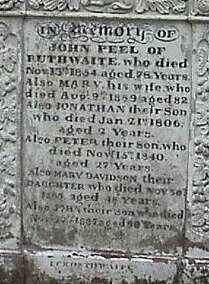|
John Peel was born at Greenrigg, a small hamlet outside Caldbeck, in 1776, the son of a yeomen farmer. The exact date of his birth is not known, but his batism was recorded in the parish church register the following year.
When barely out of his teens, John fell in love with a local girl, Mary White, then 18 from nearby Uldale. They were fordidden from marrying by John's mother, but they galloped to Gretna Green (17 miles north) and married. They had 13 children.
John was a farmer, not from the gentry. He managed to hunt two and sometimes three days a week.
|

John Peel 1776 - 1854
|
|
It was the prospect of steady work that attracted John Woodcock Graves, a restless young coach painter from nearby Wigton, to move into the village for a job as a mill manager. That's where he met John Peel who kept a kennel of hounds - for which he earned £40 a year by hiring them out to various hunts. John later became the local MFH (Mater of Foxhounds).
When both men were in the heyday of their manhood they met one night at Graves's house at Caldbeek, to arrange some hunting matter. The grandmother of Graves's children was singing a child to sleep with an old nursery rhyme known as Bonnie Annie, or Whar wad Bonnie Annie lie, and Graves became struck by the idea of writing a song in honour of Peel to the tune the old lady was singing. He completed a version before Peel left the house and jokingly remarked 'By Jove, Peel, you'll be sung when we are both run to earth'. Peel died in 1854, aged seventy-eight, and was buried at Caldbeck. The song, sung to a version of Bonnie Annie, seems to have had a long traditional popularity before it got into print, and was probably first published on a music sheet by Mr William Meteclfe of Carlisle about 1870 or 1880. There are two distinct versions of the tune of John Peel, the one being a corruption from the other, and both differing materially from the old nursery rhyme. The tune Whar wad Bonnie Annie lie or Whar wad our Guidman lie, is found in several early Scottish publications. It is, however, founded on an English Country Dance called Red House, printed in The Dancing Master, 1703, and greatly used in the early ballad operas of the first part of the 18th century. See John Peel site.
John peel, the man and the song - full story here
And a full story: The story of a song appear in the Summer 2001 edition of Evergreen - magazine article - not on line.
|


The Peel Family gravestone at Caldbeck was repaired after being damaged by anti-hunt protesters
Popular though the folk-song became, it nevertheless proved to galling for the militant anti-blood sports protesters, for in 1977 they went up to Caldbeck one night and cracked John Peel's headstone in the churchyard, dug a hole in the grave and threw the head of a fox into it..
The gravestone has been repaired, and the Peel family's remains were found not to have been disturbed, bu the evil desecration caused a severe loss of support for the anti-hunting lobby.
|
Do ye ken John Peel?
Do ye ken John Peel with his coat so grey?*
Do ye ken John Peel at the break of day?
Do ye ken John Peel when he's far, far away
With his hounds and his horn in the morning.
Chorus:
Twas the sound of his horn brought me from my bed
And the cry of his hounds has me oftimes led
For Peel's view holloa would wake the dead
Or a fox from his lair in the morning
2. Do ye ken that hound whose voice is death?
Do ye ken her sons of peerless faith
Do ye ken that a fox with his last breath
Cursed them all as he died in the morning?
Chorus:
3. Yes, I ken John Peel and auld Ruby, too
Ranter and Royal and Bellman so true
From the drag to the chase, from the chase to the view
From the view to the death in the morning
Chorus:
4. And I've followed John Peel both often and far
O'er the rasper fence and the gate and the bar
From Low Denton Holme to the Scratchmere Scar
When we vied for the brush in the morning.
Chorus:
5. Then here's to John Peel with my heart and soul
Come fill, fill to him a brimming bowl
For we'll follow John Peel thro fair or thro foul
While we're waked by his horn in the morning.
Chorus:
|
Forward to Memorable Images 36
Back to Memorable Images 34
|

